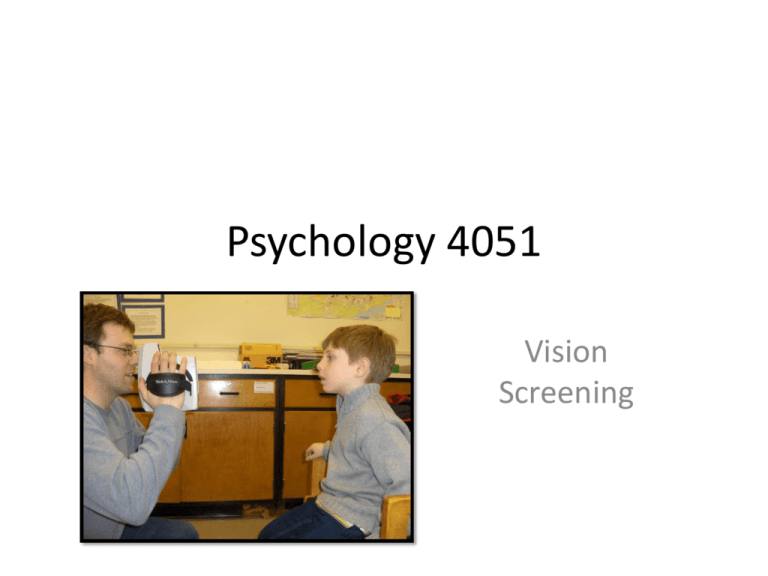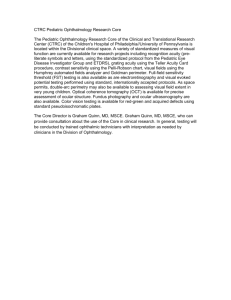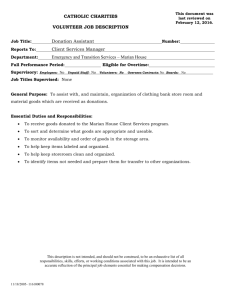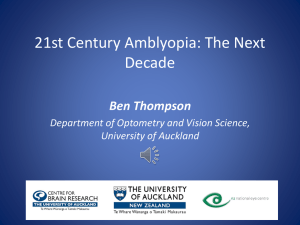Psychology 4051
advertisement

Psychology 4051 Vision Screening Vision Screening • The duration over which one suffers from an amblyogenic factor is critical in determining outcome of treatment. • The earlier we detect amblyogenic factors, the shorter the duration of deprivation, the better the outcome. • Most researchers and clinicians advocate vision screening as soon as children are capable of completing an optotype visual acuity test. Recommendations • Most North American vision/pediatric organizations recommend that visual acuity be assessed along with alignment of the eyes. • Vision/pediatric organizations are also starting to realize the value of autorefraction and photoscreening. What Should be Screened? Visual Acuity • Visual Acuity provides a direct measure of functioning and therefore, should be measured in preschoolers. • Optotype acuity tests are recommended. – Resolution acuity tests (like the Teller acuity cards) are not recommended because they generally overestimate visual acuity in children and adults with amblyopia – Note however, we have found that 76% of all cases of amblyopia can be detected using the Teller acuity cards (Drover et al., 2009). What Should be Screened? • HOTV, Lea Symbols, and PattiPics following logMAR format are recommended. • However, young children have some difficulty with linear optotype tests. • Completion rates tend to be higher with isolated optotype tests in which a single optotype is shown at a time. • But, the crowding effect is critical in detecting children with amblyopia. What Should be Screened? • This can be remedied using isolated optotype tests in which letters are presented surrounded by crowding bars. • The crowding bars produce a crowding effect making the optotype difficult to detect. What Should be Screened? • It is also recommended that visual acuity testing be conducted at a distance of 10 feet rather than the traditional 20 feet. • Preschoolers are shy • A well-lit 20 foot room is difficult to find in a daycare centre. What Should be Screened? Ocular Alignment • Hirschberg corneal reflex and the cover test are commonly recommended. • In the Hirschberg corneal reflex, the patient fixates a small penlight which is shone into the child’s eyes from a distance of 40-50 cm. • The positions of the corneal reflections should be the same in each eye. What Should be Screened? • During the cover test, the patient fixates a target from a distance of 3m (distant cover test) or 40cm (near cover test). • One eye is covered repeatedly (usually three times) with a plastic occluder (ie., a plastic paddle) for about 3 seconds at a time. • If the uncovered eye has to shift or move to find the target when the other eye is covered, this is evidence that the eyes are misaligned. What Should be Tested? • In the figure below, a child who has an obvious case of exotropia is being tested. What Should be Screened? Stereopsis • Assessment of ocular alignment requires expertise either in the administration of the procedure, or the interpretation of the results. • Thus, these tests should only be conducted by an optometrist or ophthalmologist. • This poses a problem for preschool vision screening. • Ideally, you want to use tests that can be carried out by educated people with no specific training in vision assessment. What Should be Tested? • Perhaps a more suitable alternative to the assessment of ocular alignment is the measurement of stereopsis. • If a child’s eyes are misaligned, they should have poor stereoacuity and should be detected with stereopsis tests. • Children can be tested with the Randot Preschool Stereoacuity test. • They can also be tested with the Randot E Stereotest. What Should be Tested? • The subject is present with two random dot plates (see Figure below). • When wearing the polarized glasses, one plate will appear to have an “E” that floats above the plate. The other is a blank. • The subject has to point at the plate that has the “E”. • Subjects can be tested at 50, 100, and 150 cm which correspond to stereoacuity of 500, 250, 168 arc sec. New Directions Refractive Error • Many pediatric/vision organizations now recommend the assessment of refractive error. • This can be done using photoscreeners and autorefractors. • The major advantages of these techniques are: – Rapid: they can provide estimates of refractive error in less than 2 mins. – Objective: no judgments have to be made on the part of the tester. – No response is required on the part of the subject. – No Expertise Required: these techniques are so simple no vision training is required. New Directions Contrast Sensitivity • CS: the minimum amount of contrast required to detect sine wave gratings at different spatial frequencies. • Measures one’s sensitivity to size and contrast simultaneously. • Measured by assessing one’s contrast threshold to sinewave gratings at different spatial frequencies. New Directions • Can be measured in preschoolers using contrast sensitivity cards (see below). • The CS cards consist of 40 cards arranged in 5 spatial frequency sets. • The lowest contrast sine wave grating detected at each spatial frequency is a measure of contrast threshold. New Directions • Despite its promise, no screening study has evaluated whether contrast sensitivity is effective in detecting amblyopia or amblyogenic factors in preschoolers. New Directions Vernier Acuity • Vernier acuity may be appropriate for vision screening because it appears to be mediated by the visual cortex. • Amblyopia is a disorder that is cortical in nature. • Thus, if amblyopia exists, it should be detected with vernier acuity. • In fact, adults with amblyopia possess severe vernier acuity deficits in the amblyopic eye (Levi & Klein, 1982). New Directions • Can be assessed using the vernier acuity cards. • Cards covered in a square wave grating that contains a misalignment in stripe position in the form of a flower or star. • The smallest amount of misalignment at which the shape is detected provides a measure of vernier acuity. New Directions • Can also be assessed using the Preschool Vernier Acuity Booklet which we developed in Dallas. Star Flower New Direction • The book contains square wave gratings arranged in groups of 4. • One grating possesses a misaligned star, another possesses a misaligned flower. • The other two are blank. • The subject has to identify the star and the flower. • The lowest level of misalignment at which the subject identifies the star and flower provides a measure of vernier acuity. • No screening study has assessed whether vernier acuity is effective in identifying cases of amblyopia.





